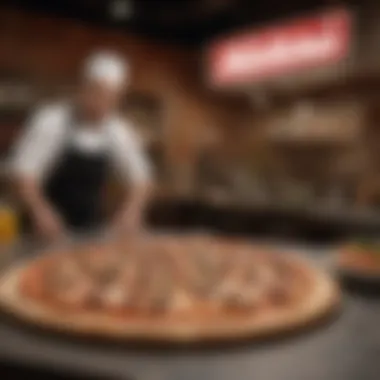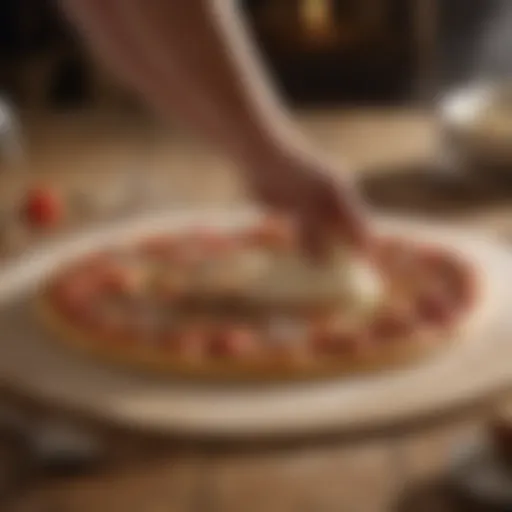Exploring Pizzaria Napoletana: Tradition and Taste


Intro
In the culinary landscape, few traditions can rival the allure of Pizzaria Napoletana. This style of pizza, originating from Naples, embodies not only a method of cooking but also a cultural identity that has evolved over centuries. Its simple ingredients and traditional techniques reflect the resourcefulness of Neapolitan chefs and the warmth of the Italian spirit. By delving into this rich heritage, we can better understand the evolution and significance of Pizzaria Napoletana.
Pizza Recipe Prologue
To fully appreciate this Italian staple, one must understand the elements that create a truly authentic Neapolitan pizza. This section highlights the traditional recipes while integrating modern interpretations that keep these culinary practices alive in today's kitchens.
Overview of the pizza recipe being featured
The focus of this article is the classic Margherita pizza, a timeless representation of Pizzaria Napoletana. Combining a perfectly cooked thin crust, rich tomato sauce, fresh mozzarella, fragrant basil, and a drizzle of extra virgin olive oil, Margherita is a tantilizing blend of flavor and texture.
Key ingredients needed
Key ingredients for a typical Margherita pizza include:
- Type 00 flour: for a smooth dough.
- Water: fresh and lukewarm, ideal for yeasting.
- Salt: to enhance flavor.
- Yeast: to help the dough rise and get a nice texture.
- San Marzano tomatoes: for the sauce, known for their rich flavor.
- Fresh mozzarella: crucial for the creamy melt.
- Fresh basil: offering a fragrant garnish.
- Extra virgin olive oil: for finishing touch.
Inspirations behind the recipe
The Margherita pizza derives its name from Queen Margherita of Savoy, whose visit to Naples in 1889 inspired its characteristics and presentation. It is believed that the red, white, and green of the ingredients pay homage to the colors of the Italian flag. Understanding this cultural and historical context adds significance to this simple dish, making every bite a taste of history.
Ingredients and Preparation
Detailed list of all ingredients required
To make the classic Margherita pizza, gather:
- 1 cup of lukewarm water
- 500 grams of Type 00 flour
- 1 teaspoon sea salt
- 1 teaspoon instant yeast
- 400 grams of San Marzano tomatoes, crushed
- 300 grams of fresh mozzarella, sliced
- Fresh basil leaves
- Extra virgin olive oil, as needed
Step-by-step instructions for preparing the pizza dough and sauce
- Mix the Dough: In a large mixing bowl, combine the yeast and lukewarm water. Gradually add flour and salt, then knead the mixture until smooth (about 15 minutes).
- Let it Rise: Place the dough in a greased bowl, cover it, and set in a warm area. Permit it to rise for 1-2 hours or until it doubles in size.
- Prepare the Sauce: Take crushed San Marzano tomatoes, and mix in a pinch of salt. This will be your sauce, ready for spread.
Tips for preparing and handling the ingredients
- Always use fresh ingredients. They are the cornerstone of Neapolitan pizza.
- Handle the dough gently after rising to maintain air bubbles for the crust's lightness.
Assembly and Baking
Instructions on assembling the pizza with toppings
- Preheat your oven to its highest temperature (ideally 480°C).
- Once the dough has risen, transfer it to a floured surface. Shape a round base, leaving a slightly raised edge for the crust.
- Spread a thin layer of the tomato sauce on the dough. Do not much all sauce—could make dough soggy.
- Evenly distribute sliced mozzarella on top and purity with fresh basil leaves.
- Drizzle a little extra virgin olive oil before placing in the oven.
Tips for achieving the perfect bake - oven temperature, baking time, etc.
Bake the pizza for 90 seconds to 2 minutes. Watch the crust for a perfect golden brown color where the bubbles form. You need a very high heat to finish this task.
Variations and customization options for the recipe
Adding toppings like prosciutto, arugula, or various vegetables can create a personal twist. They should always be added sparingly to preserve that authentic Neapolitan base.
Serving Suggestions and Pairings
Recommendations for serving the pizza - garnishes, additional toppings, sauces
Serve immediately while hot. Add crushed red pepper flakes for those whipped with spice or more basil for extra aroma.
Pairing suggestions - beverages, side dishes to complement the pizza
Pair with a light Italian white wine like Pinot Grigio, or for a non-alcoholic option, sparkling water works well to cleanse the palate.
Cook's Notes and Tips
Additional tips and tricks for enhancing the flavor and texture of the pizza
Using a pizza stone can significantly improve the cooking process, as it retains heat and results in a crispy bottom crust. Sticking to simple garnishes allows the core flavors to shine.
Troubleshooting common issues during the preparation and baking process
Prevent soggy pizza by ensuring dough is well-leavened without excess toppings. Set up a timer to help reach that perfect bake without overdoing t it.
Thus, understanding the nuances of best practices—with preparation, cooking, and serving particulars—creates room for appreciation beyond simple nourishment.


Prelims to Pizzaria Napoletana
Neapolitan pizza is more than just sustenance; it is a cultural icon that encompasses a rich tradition steeped in history. The introduction to Pizzaria Napoletana sets the stage for understanding its significance in the world of cuisine. This section aims to delve into the origins, aesthetics, and sensory experiences associated with Neapolitan pizza.
The first aspect to consider is its historical background, which illustrates how the evolution of pizza reflects the socio-economic changes in Naples. Each layer of crust, cheese, and sauce narrates a story of regional ingredients and local cooking methods that have dazzled food lovers for generations.
Much attention should be placed on the authenticity of Neapolitan pizza. The Accademia Napoletana del Pizzaiuolo plays an essential role in regulating the preparation standards that ensure pizza retains its cultural integrity. Understanding these standards is critical for both gastronomy enthusiasts and professionals in the pizza-making craft.
As we move further into the depths of the article, readers will see how ingredient quality captures the spirit of the region. Flour, tomatoes, and mozzarella serve as the foundational elements. This component connects not only to taste but also to the culinary identity that differentiates Neapolitan pizza from other styles worldwide.
The multifaceted experience of enjoying pizza unpacks a sensory narrative. The aroma, texture, and flavor combine to form a memorable dining moment, often enhanced through communal preparation and eating. Such experiences go beyond just food; they embody values of sharing and tradition.
Finally, modern trends in preparation, such as health-conscious variations and global influences, showcase adaptability while still paying homage to traditional practices. This balance will be explored in detail throughout the article, inviting readers to appreciate both the historical depth and the modern complexities of Pizzaria Napoletana.
In essence, Pizzaria Napoletana represents a crossroads between antiquity and contemporary culinary innovation.
Historical Background of Neapolitan Pizza
The historical background of Neapolitan pizza is not only a fascinating subject but essential for understanding its evolving character. From its ancient origins to the recognition it received from UNESCO, the journey of Neapolitan pizza offers insightful perspectives on food as a cultural artifact. Throughout the centuries, this dish has undergone transformations influenced by various cultural exchanges, yet it has maintained a distinctive identity aligned with Neapolitan heritage. Knowledge of this background enriches appreciation for the artistry involved while enhancing the culinary experience.
Ancient Origins
The origins of Neapolitan pizza date back to the 18th century in Naples. At that time, pizza existed primarily as a working-class dish. Available food vendors created it using simple ingredients, often crafted in forms far removed from today's design. These enthusiasts baked the flatbreads in wood-fired ovens, typically used for some other food preparation. The inclusion of tomato, which arrived from the New World, became popular during this time. Prior to mushrooms and cheese, tomatoes influenced the transformation and flavor enhancing choices in pizza. From humble beginnings, it grew to represent more than just insolvency but wealth of flavor and creativity.
Cultural Influences through Centuries
Throughout the years, a wide array of cultural influences have shaped the development of Neapolitan pizza. Interaction among the Spanish, French, and other surrounding regions brought forth diverse flavors and additions. Over time, the pizza began to evolve with ingredients reflective of these changes. For instance, the introduction of buffalo mozzarella highlighted the Southern Italian angle, as local produce brought richer flavors to simple constructions of dough and topping. Additionally, street peddlers transformed the pizza into a communal consumable accepted by various social classes in Naples, thus playing a role in unifying people through food rather than dividing them.
Recognition by UNESCO
On December 7, 2017, Neapolitan pizza officially achieved UNESCO recognition as an intangible cultural heritage. This recognition underlines the importance of traditional practices involved in its making, from the selection of ingredients to the cooking methods. It emphasizes that such culinary traditions carry historical and cultural narratives,- bridging connections between the past and present. This acknowledgment broadens the scope for safeguarding traditional dishes like Neapolitan pizza. Celebrations relating to this cultural heritage boost local economies and contribute to a renewed interest for preserving and promoting authentic products. The recognition by UNESCO solidifies Neapolitan pizza as not just a meal, but a significant part of world culinary history.
Core Ingredients in Neapolitan Pizza
The essence of Neapolitan pizza lies in its core ingredients. Each component is critical for both authenticity and flavor. Understanding these basic elements reassures pizza lovers that Neapolitan pizza is more than just a culinary choice; it is an art forged from tradition, culture, and craftsmanship. The balance of quality ingredients brings out the flavors distinct to this pizza style and ensures an enjoyable dining experience.
Types of Flour
Flour constitutes the foundation of any pizza. For Neapolitan pizza, only specific types of flour will suffice.
The ideal flour is Caputo 00, milled from high-protein, soft wheat. This flour has a fine texture, ideal for producing a stretchy, soft dough. The importance of protein content cannot be overstated. It influences dough elasticity and consistency. Higher protein flour, ranging from 11.5% to 12.5%, allows for a better rise.
Those who seek authenticity should consider the gluten content as well. Gluten contributes crucial structural properties to the dough, allowing it to hold its shape as it bakes. Moreover, there are other flours varieties used in the area that can also at times replace the Caputo 00, which is vital for achieving the desired crust.
Using the right flour ultimately impacts the texture, chew and overall satisfaction of the final pizza product.
Tomato Varieties
Next, tomato varieties hold equal importance. The type of tomato used can significantly influence the final taste of a Neapolitan pizza. Authentic varieties like San Marzano tomatoes, grown in the volcanic soil of Mount Vesuvius, are cherished. Their sweetness and lower acidity make them perfect for pizza.
These tomatoes are typically harvested at the peak of ripeness and canned quickly to preserve their fresh flavor. When used by pizzerias, the pureed form gets seasoned slightly or used directly atop the dough.
Pace slow and carefully when adding tomatoes: fresh herbs, olive oil, or even subtle spices may combine with the basic sauce to enhance depth, but simplistic freshness best captures the essence of Neapolitan tradition.
Mozzarella: The Heart of the Pizza
Mozzarella serves as a distinctive feature in Neapolitan piza. The standard is buffalo mozzarella, a soft cheese made exclusively from the milk of water buffalo. Creamy and rich, it delivers stimulating experiences to the taste buds. This cheese's moisture content invites caution: too much can make the pizza soggy, while too little leads to contradictions in taste and balancing.
Selecting the right mozzarella adds nuances of milk character to the pizza. Chefs often opt for fior di latte, a cow’s milk mozzarella. It tends to be denser and milder, which can work just as well, but buffalo mozzarella shields a traditional touch with its superior flavor profile.
The cheese's melt quality contributes to visually appealing top bands of delectation on gentle pizza drip we love to see as cheese overtakes appears brownish clean back in the oven, generating those sought tips for bite contrasting just right.
Ultimately, the careful selection of flour, tomatoes, and mozzarella impacts the quality and taste of Neapolitan pizza profoundly. Investing time in sourcing proper ingredients can elevate the culinary art of pizza to new heights, marrying tradition with taste.
The Art of Dough Preparation
The preparation of dough serves as the foundational step in creating Pizzaria Napoletana. It transcends beyond mere mixing of flour and water; it calims age-old techniques and cultural significance. Understanding the art of dough is thus not just getting started with the process. It reflects a deep connection to tradition, essential for authentic Neapolitan pizza. The significance lies in how the dough is prepared, influencing texture and flavor of the final product.
Kneading Techniques
Kneading dough is an essential action that aids in developing gluten, providing structure to the final pizza crust. Initially, one should utilize clean, dry hands or a light dusting of flour to avoid sticking. There are various kneading methods you can choose from:
- Traditional Hand Kneading: This method provides a hands-on experience, allowing the cook to
Traditional Cooking Methods


The role of traditional cooking methods in the creation of Neapolitan pizza cannot be overstated. These methods not only reflect the foundational techniques passed down through generations but also emphasize the social and cultural significance of preparation. Authenticity is paramount in the realm of Pizzaria Napoletana, and the adherence to time-tested, traditional methods greatly enhances both the flavor and texture of the final product. Focusing on wood-fired ovens, optimal baking times and temperatures, and the unique role of smoke introduces readers into the heart of pizza-making. This section unpacks the intricacies involved in creating distinguished Neapolitan pizza using the techniques cherished in Naples.
Wood-Fired Ovens
Wood-fired ovens remain an essential element in the preparation of Neapolitan pizza. Their design and function offer a unique experience that electric or gas ovens cannot replicate. High temperatures generated by burning wood provide an intense heat necessary for properly cooking the pizza. Most wood-fired ovens can reach up to 900°F (about 482°C). This temperature is crucial for achieving the characteristic burn spots and crispy crust that Neapolitan pizzas are renowned for.
The way wood contributes to cooking should not be underestimated. Specific types of wood, such as oak and ash, are preferred for the unique flavors they impart. Working with a wood-fired oven requires skill and experience. pizza makers must adjust cooking techniques based on the flames' intensity and the oven's heat distribution. Thus, understanding wood-fired oven cooking is fundamental to experiencing authentic Neapolitan pizza.
Baking Times and Temperatures
When it comes to baking Neapolitan pizza, both timing and temperature must be closely monitored. A well-executed bake lasts a mere 60 to 90 seconds at high temperatures, where the crust swiftly transforms into a golden masterpiece while ensuring a soft and pliable interior.
The baking process also significantly impacts the dough's structure. Insufficient baking results in a raw, chewy texture that is less than desirable. Conversely, baking for too long can lead to a burnt or overly stiff crust.
Achieving that ideal bake condition requires both art and science. Pizzaiolos must be equipped with not only their trained instincts but also an understanding of the physics behind ovens and baking methods. Overall, the interplay of heat and time is essential to the Neapolitan style and contributes centrally to the charm of Pizzaria Napoletana.
The Role of Smoke and Flavor
The presence of smoke in the cooking environment of a wood-fired oven affects the flavor profile of the finished pizza significantly. The combustion from the wood creates a layer of smoky aroma, further enriching the natural taste of the dough, tomato sauce, and cheese.
Smoking adds depth and enhances other ingredients, making it a key component in elevating the flavor experience. Some producers even experiment with specific wood types to influence the flavor outcome. Each variation brings a new element, as different woods have unique characteristics.
In traditions where flavors matter profoundly, the interaction of smoke and flame serves to elevate Neapolitan pizza, creating an unforgettable sensory experience. Recognizing how essential cooking methods, baking precision, and smoking protocols overlap with flavor serves not only the palate but also the cultural narratives that surround Neapolitan pizza.
To appreciate Neapolitan pizza fully, one must recognize its roots, especially in the use of traditional cooking methods that are essentials to its signature flavor.
Pizzas of Pizzaria Napoletana
Pizzas serve as the zenith of Pizzaria Napoletana's culinary offerings. They not only epitomize the essence of Neapolitan tradition but also showcase the importance of using high-quality ingredients. Each pizza tells a distinct story, reflecting the values incarnated in the tradition of Neapolitan pizza-making. This section will explore the most paramount pizzas, celebrating their individual characteristics as well as their contributions to this revered cuisine.
Margherita: A Classic
The Margherita pizza stands as a beacon of simplicity and tradition. Crafted primarily from three essential toppings—San Marzano tomatoes, fresh mozzarella, and basil—it encapsulates the Italian flag's colors. This pizza is not just food; it embodies history. Named after Queen Margherita of Savoy, it symbolizes the unification of Italy.
The dough beneath remains crucial as it is generated through meticulous processes, producing a crust that strikes the right balance between chewyness and crunch. Every bite is a celebration of the harmony between the basic toppings. Additionally, the quality of mozzarella made from water buffalo's milk enhances its delicate flavor profile. Locals reserve a deep affection for this classic, believing that it reflects the genuine spirit of Naples.
Marinara: The Simplicity of Flavor
Venerated by many as one of the oldest pizza varieties, Marinara relies on fewer ingredients to deliver a burst of flavor. Featuring just tomatoes, garlic, oregano, and a drizzle of olive oil, this pizza's charm lies in its beautiful simplicity. Unlike other styles with heavy toppings, the Marinara allows the natural flavors of the tomatoes and spices to shine.
The choice of ingredients remains paramount here. Optimal ripeness in tomatoes and fresh herbs brings out true authenticity. The Marinara, often viewed as the ideal option for purists, emphasizes the principle that less can indeed be more. It makes the palatability uncomplicated, yet deeply satisfying. Its robust flavor profile caters to an audience that appreciates a straightforward, yet fulfilling culinary experience.
Innovative Toppings and Combinations
While tradition remains paramount, the landscape of Pizzaria Napoletana is also favorable for creativity. Discerning chefs often test the boundaries by introducing innovative toppings that infuse local produce or exotic ingredients into traditional bases. From truffle oil to artisanal cheeses, these variations seek to elevate the classic pizza experience while retaining its heart.
Such creativity motivates pizza lovers to experiment, creating a richer dining experience. However, balancing these innovative elements with respectful treatment of tradition becomes crucial. Interestingly, novel configurations within this traditional framework enhance discussions about authenticity in gastronomy. As restaurants across the globe pioneer in this realm, they invite food enthusiasts to explore unexpected flavors that might strike the right chord.
Thus, the hallmark of Pizzaria Napoletana is not only the steadfast adherence to recipes but also the innovative spirit that holds its place as well. The proliferation of novel toppings makes culinary experimentation both a delight and a feast.
By weaving tradition with innovation, Pizzaria Napoletana continues to captivate pizza lovers worldwide, marrying age-old recipes with the excitement of today.
Contemporary Adaptations
Contemporary adaptations of Neapolitan pizza highlight the evolving nature of this time-honored tradition. As global influences merge with local tastes, new interpretations emerge, reflecting regional preferences and dietary trends. These adaptations are notable not only for their innovative toppings and ingredients but also for their implications on cultural identity and gastronomy as a whole.
Global Influences on Neapolitan Pizza
The impact of globalization cannot be overstated. Neapolitan pizza now incorporates flavors and ingredients from various cultures around the world. Chefs in places like Tokyo or Mexico City create unique pizza experiences using local produce and culinary styles. The essence of the traditional pizza remains, but layers of taste diversify the offering dramatically. This fusion enhances the overall pizza culture while maintaining links to classic Neapolitan roots.
Popular additions found in contemporary pizzas include:
- Pico de gallo in Mexican adaptations
- Wasabi and seared miso in Japanese interpretations
- Curry spices introduced in Indian variations
This merging of flavors invites creativity within pizza-making. It fosters a dialogue within the food community. Chefs regularly reinterpret what a Neapolitan pizza can be while keeping the core elements intact.
Fusion Recipes and Unique Offerings
Fusion recipes serve as a canvas for chefs eager to push boundaries. The curiosity to experiment is one of the most compelling reasons behind contemporary adaptations. While many might seek authenticity, others find excitement in reimagining a classic. Options such as caramelized onion and brie pizza or sriracha-infused barbecue chicken pizza stand as testaments to creative expression in gastronomy.
Additionally, culinary enthusiasts occasionally challenge traditional pairing models with food that might seem incompatible at first. Yet, contrasting flavors add novel experiences for eager palates. Unique offerings encourage consumers to step outside their comfort zones, further celebrating the versatility of the pizza medium.
Health-Conscious Variants


Health-conscious variants of Neapolitan pizza pave the way for inclusivity in gastronomic pleasure. As awareness of dietary needs and preferences increases, pizzarias innovate healthier options without sacrificing flavor. These variants often cater to common dietary blocks, such as gluten sensitivities or vegan lifestyles, allowing more people to enjoy this beloved dish.
Healthier options may feature:
- Cauliflower crusts as a gluten-free alternative
- Nutritional yeast replacing cheese in vegan selections
- Whole grain or ancient grains for traditional flour alternatives
Such adaptations underscore an important point: pizza can be part of a balanced and thoughtful diet. By providing accessible choices, pizzarias aimed at maintaining their customer base while promoting a healthier lifestyle.
It is essential to acknowledge the brilliance behind such adaptations. When the essence of Neapolitan pizza embraces modification, it fosters growth and sustains tradition at the same time.
Pizzaria Napoletana Around the World
Pizzaria Napoletana represents not just a style of pizza, but a worldwide cultural phenomenon that has transformed how people across the globe perceive Italian cuisine. The authentic Neapolitan pizza is highly prized for its quality and flavors, attracting pizza lovers beyond the borders of Italy.
This spread of Pizzaria Napoletana can be seen as a tribute to its exquisite tradition, following rigorous standards and techniques. Many establishments worldwide attempt to uphold the practice of crafting genuine Neapolitan pizza, brightening the gastronomic landscape with their presence.
Popular Locations and Establishments
Various cities have embraced Pizzaria Napoletana's charms, cultivating communities around this unique culinary art. Notable establishments emerge frequently, contributing to a dynamically evolving pizza culture. Some famous locations:
- Di Matteo in Naples, known for its wood-fired oven and traditional ingredients. This historical pizzeria showcases the essence of Neapolitan flavor.
- Pizzeria Sorbillo, another gem in Naples. Severe contiguous lines reflect its revered status, giving a testament to the quality deeply rooted in tradition.
- Outside Italy, Establishment 2 in Los Angeles captures the heart of Pizzaria Napoletana, acclaimed for its use of artisanal techniques in sourdough crusts.
These establishments create dedicated fan bases, enhancing their ability to maintain strict adherence to authentic methods
The Rise of Neapolitan Pizza Chains
Recently, there has been a rise in national and international chains specializing in Neapolitan pizza. Chains like Rossopomodoro and Pizzeria Locale have spread across different countries while remaining committed to showcasing time-honored recipes and standards.
This scaling has several benefits but also challenges. They provide pizza enthusiasts with quick access to quality offerings outside of Naples. However, noise created by diverse flavors may dilute authentic pizze standards. It poses essential considerations in how lip-smacking flavor continues to be delivered at different scales—which leads us to think about whether those pizzas maintain integrity.
Culinary Competitions and Festivals
Across the world, culinary competitions and festivals have sprung up to further elevate the Neapolitan pizza conversation. Events such as the Pizzafest held in Naples gather pizzaiolos and enthusiasts to celebrate art and passion significantly.
Competitions like Pizza World Championship and others held yearly invite participants in discerning techniques through added dimensions of flavor.
These expos serve dual purpose. They not only highlight the work of skillful pizza makers but also unearth hidden gems, encouraging innovation while maintaining the focal point of tradition. Crowds delight in numerous tastings and workshops, eager to expand their culinary knowledge of the Pizzaria Napoletana traditions. Through these experiences, a new audience gets to appreciate the beautifully crafted flavors that Neapolitan pizza offers, allowing for culinary bridges between communities.
The enduring popularity of Pizzaria Napoletana worldwide is tied deeply to its adherence to tradition and the ability to engage a community with every bite—celebrating authentic techniques while allowing space for new interpretations and flavors that both challenge and respect tradition.
In essence, the exuberance surrounding Pizzaria Napoletana continues worldwide as cafes respond creatively while remaining resolute in honoring the essential qualities that give Neapolitan pizza its mark of excellence.
Ending: The Enduring Legacy of Pizzaria Napoletana
The discussion around Pizzaria Napoletana allows us to witness not just a culinary delight, but also a history steeped in cultural significance. Neapolitan pizza possesses an unrivaled identity that has interwoven with the fabric of various communities. Its journey began in humble origins and has flourished globally, bridging generations and cultures through a shared appreciation for taste and tradition.
Importance of Pizzaria Napoletana
The essence of Pizzaria Napoletana lies in its authenticity. Every ingredient utilized, from the selected flour to the choice of tomatoes, contributes to a singular experience. This pursuit of perfection elevates the simple act of eating into a ritual that connects the eater to regions, stories, and memories of Naples. Recognizing the process of dough preparation and cooking methodologies is crucial. These are not arbitrary choices, but time-tested techniques designed to maximize flavor and texture. The intense heat of the wood-fired oven and the minimalistic approach to toppings create a canvas for both tradition and innovation.
Ongoing Global Influence
As the popularity of this pizza style grows, it has inspired interpretations all over the world. Beyond Italy, numerous pizza shops now celebrate Neapolitan characteristics while introducing elements from local culture. This two-way street enables both maintaining traditional touchstone and creating Diverse variations that speak to a wider audience. Yet, it is vital to remember and honor the roots from which it evolved. Without these traditions, the essence of Pizzaria Napoletana could blur or diminish.
Sustaining Culinary Heritage
It is important to consider the heritage and the authenticity issues. With increasing access to more foods and culinary practices, there is a danger of cultural dilution. Passionate enthusiasts and stakeholders must advocate for true Neapolitan pizza, ensuring its distinctions and gastronomical nuances are not lost. Current custodians of this tradition are dedicated to this mission, partaking in culinary competitions and installations that underline their commitment to creating and preserving this distinctive type of pizza.
In essence, the enduring legacy of Pizzaria Napoletana serves a dual purpose. It not only offers a palate experience but also acts as a vessel of cultural exchange. Maintaining this delicate balance ensures that future generations appreciate and respect this unique tradition. That is the heart of what makes Neapolitan pizza more than just food; it embodies a rich narrative of history, culture, and creativity.
“Pizzaria Napoletana represents a blend of flavor and art—a culinary experience deeply enshrined in cultural heritage.”
As we reflect on the essence of Pizzaria Napoletana, it is clear that its significance reaches far beyond mere hunger satisfaction. The layers of taste tell stories. Through careful crafting, dedication to authenticity, and obligation to preserve its essence, this beloved pizza style will undoubtedly endure.
Resources for Further Exploration
The exploration of Pizzaria Napoletana unfolds a rich tapestry of gastronomical history, regional techniques, and veteran craftsmanship. Yet, to truly appreciate and understand this world, supplementary resources are vital. These resources not only augment our knowledge but also contribute to a robust culinary experience.
Many enthusiasts and scholars recognize the significance of examining texts and materials that explore Neapolitan pizza. Notable books offer insights into the culture surrounding the dish, its ingredients, and the methodology behind its preparation. These can guide both novice and seasoned cooks in perfecting their skills and expanding their understanding of authentic practices.
Furthermore, online platforms serve an essential role in this culinary journey. Websites like Wikipedia provide concise historical backgrounds, while Britannica offers scholarly articles related to the techniques of wood-fired baking and fermentation. Community discussions on Reddit can give firsthand accounts from pizza lovers and chefs alike, fostering engagement and shared insights.
“Exploring different resources brings not only knowledge but also inspiration!”
Below are important aspects to consider when looking for resources on Pizzaria Napoletana:
- Books: Look for titles focusing on traditional methods and recipes of Neapolitan pizza.
- Documentaries: Visual explorations present delight proposes regarding techniques and styles throughout Italy.
- Online Courses: Some culinary schools ooffer classes tailored to mastering the art of Neapolitan cooking.
- Forums: Cooking communities often discuss critical methodologies and personal experiences with various pizzas, enhancing collaborative learning.
Engaging with these resources affords a deeper connection to the traditions and evolutions of Pizzaria Napoletana. As a pizza lover, pursuing this information will enrich your cooking endeavors as well as dining experiences. Experiencing the little-known nuances of Neapolitan pizza not only satisfies appetite; it cultivates cultural understanding.
For those interested, here are some linking facgets for additional reading: Wikipedia , Britannica, Reddit, Facebook.







